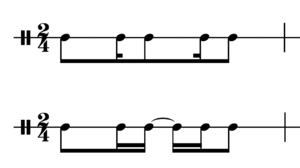Cinquillo
This article includes a list of general references, but it lacks sufficient corresponding inline citations. (February 2012) |
A cinquillo is a typical Cuban/Caribbean rhythmic cell, used in the Cuban contradanza (the "habanera") and the danzón.[1] The figure is also a common bell pattern found throughout sub-Saharan Africa. It consists of an eighth, a sixteenth, an eighth, a sixteenth, and an eighth note. Placing this rhythm in a 2/4 measure, it obtains a strongly syncopated character from the sustained note which replaces an articulated one on the first quarter of the second beat. Cinquillo is an embellishment of the more basic pattern known as tresillo. Cinquillo is shown twice below. The first one (above) merely displays the note values. The second one (below) is a so-called orthographic notation, which gives an impression of the syncopated character.
When followed by four unsyncopated eighth notes, it is known as the baqueteo. Like the clave, this forms a pair of measures, syncopated and unsyncopated. The baqueteo is in fact, is an embellishment of clave, as it contains all of that key pattern's strokes. The baqueteo is shown below with both cells contained within a single measure.
An example of baqueteo in popular music is the introduction of the 1994 hit "Come Out and Play" by American punk rock band The Offspring.

The biguine uses a cinquillo variant related to that found in other Caribbean genres.
References
- ^ Mauleón, Rebeca (1993: 51). Salsa Guidebook: For Piano and Ensemble. Petaluma, CA: Sher Music.

